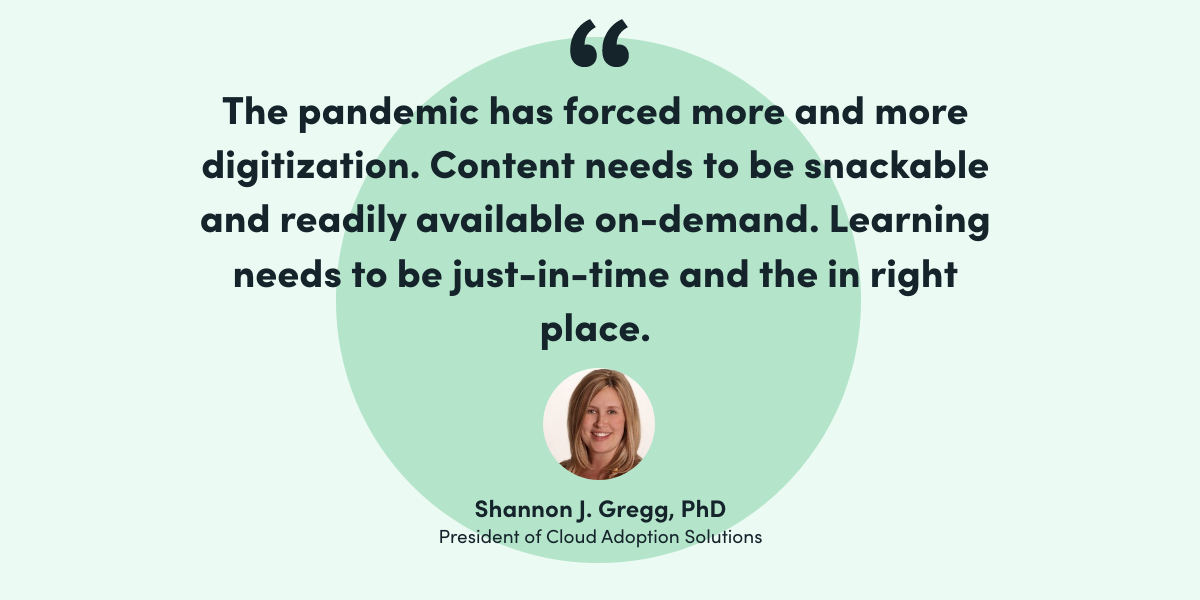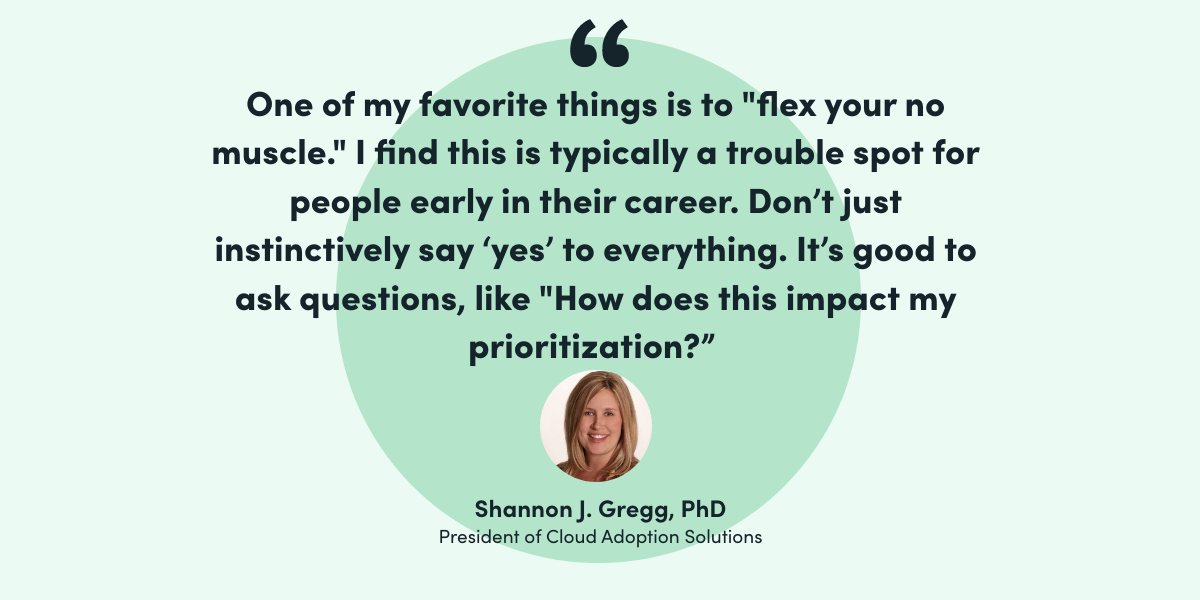Our VP of Partnerships Zak Pines recently interviewed Shannon Gregg, President of Cloud Adoption Solutions, as part of our ongoing Partner Interview Series. Their conversation covered a wide range of topics including Shannon’s tips for promoting Salesforce adoption and finding productivity by flexing your “no” muscle. Here’s an abridged transcript of the chat.
Earning a PhD in Salesforce
Zak: Can you start by telling us background on Cloud Adoption Solutions?
Shannon: Cloud Adoption Solutions is a consulting firm focused on Salesforce optimization.
I’ve been using Salesforce since 2009 as an end user. The company I was working then for kept acquiring new businesses, and increasingly, I was involved in helping to merge and consolidate these different Salesforce solutions. One year we brought together six different Salesforce environment! I started to see patterns when Salesforce implementations were successful and when they were not.
I started Cloud Adoption Solutions in 2018 around the idea that there are specific processes to follow to make your CRM implementation successful. I had been keeping a punch list and that became the foundation for the business.
Zak: What did that punch list look like?
Shannon: There are three pillars: people, process and technology. Around this time I completed a PhD and my dissertation topic was on Salesforce user adoption.
Zak: So. you have a PhD in Salesforce. You're a Salesforce doctor.
Shannon: There are three human principles that we brought into the adoption of a software like Salesforce: change management, learning styles, and diffusions of innovation.
Zak: Can you walk me through each of these areas?
Shannon: Change management for us means that you need to be sure to have quick wins as part of your CRM implementation. People need gratification, and need to be rewarded for their efforts.
With learning style, we ask the question: "how do the individuals on your team prefer to learn?" This way we can ensure that training aligns to those learning styles.
Diffusion of innovation tells us that there are different stages along an adoption curve—from early adopters who are innovators to the majority and then laggards. We actually map out a CRM roll-out to those different phases and identify how teams and people map to that.
Zak: Those are all really interesting. On the learning techniques, are there specific trends that you are seeing for how users like to consume information and learn new products and processes?
Shannon: The pandemic has forced more and more digitization. Content needs to be snackable and readily available on-demand. Learning needs to be just-in-time and the in right place.

Zak: You’ve been talking about optimizing a customer’s Salesforce implementation. Do you also do implementations from the start?
Shannon: Yes we do. We dive deep around why a customer wants to make the investment in time and resources to roll out Salesforce. We use the 5 Whys Technique to ask those questions and make sure the right foundation is in place. Of course, we do deal with the rescue situations where there are problems and special solution needs to be brought in.
Zak: Have you found certain patterns in the types of businesses that make great customers for you?
Shannon: Regulated environments. Our discovery process lends itself well to those businesses. They are open to the intellectual curiosity, interrogation, and root cause analysis. Two of our top verticals are health life sciences and financial services.
Zak: That matches us as well. Two of our top verticals, particularly around Salesforce customers, are healthcare and financial services.
Shannon: That is what is so awesome about Formstack. It takes something tangible that a business is doing today, and allows them to transform it in a digestible way. Your customers are filling out paperwork today. But now we can make it digital in a way that’s comfortable to the customer and introduce a business process that improves what they are doing today.
Zak: It also ties to the concept you spoke about earlier: quick wins. Moving an existing manual data collection process to something more digital can be a quick win for a new or existing Salesforce implementation.
Shannon: It’s taking what you are already doing and moving it to a medium where you can have digital interactions with customers.
Zak: How did you come to learn about Formstack?
Shannon: We are a newer partner. We were aware of Formstack for a while, and then we started following Amanda Nielsen and Alaina Dononvan more recently. As we dug into the solutions, we realized Formstack can do much more things than we realized. It’s one of the best companion products you can have within Salesforce.
Finding productivity by flexing your “no” muscle
Zak: In researching for today, I see that you’ve written a book, “It’s About Time: How to do More of What Matters in the Time You Have.” Productivity is a topic near and dear to us at Formstack. Tell me more about the book.
Shannon: I’m obsessed with productivity. The book is on time management, and how to find the way to do things that matter the most.
Zak: Can you share a few tidbits from the book. What are your top productivity tips?
Shannon: One of my favorite things is to "flex your no muscle." I find this is typically a trouble spot for people early in their career. Don’t just instinctively say ‘yes’ to everything. It’s good to ask questions, like "How does this impact my prioritization?”

And also asking if you are the right person for a job. Is it a situation that you are going to be able to add value to? People should be empowered to say, “This isn’t something I can add value to right now.” Learn how to say “No, but”, or “No, and”, or “here’s another suggestion.”
Zak: That makes a lot of sense to me. That’s a consultative approach.
Shannon: “No” is a powerful word.
Zak: In the sales context, too, how you deal with “no” is an important skill.
Shannon: That’s right. We don’t need to be afraid of saying no. We should ask why someone is saying no and continue to dig deeper.
Lightning Round
Zak: What are some of your personal interests or hobbies?
Shannon: I am a judge for dance competitions; I’m on the hip hop panel at the Dance Worlds every year.
Zak: I also ask for a productivity tip in the lightning round. You shared one earlier. Can you share one more?
Shannon: I recommend batching. If you worked in a Toyota plant, you’d be putting a door on all day long. You should approach your business tasks in the same way. Batch your activities so you can get them done efficiently.
Zak: Do you have a favorite TV show past or present?
Shannon: I’m not a TV person. I listen to podcasts, though! A fun one I can recommend is “60 Songs that Explain the 90s.”
Zak: Also have to recommend Formstack’s Ripple Effect podcast.
Do you have a go-to lunch during the workday?
Shannon: I.m a huge fan of making panzanella salad. Tomatoes, old stale bread, olive oil. I eat that while walking back up the steps to my office. It’s fast and easy.
Zak: And final question Shannon. Is a hot dog a sandwich?
Shannon: I like this question. I’ll say no. It’s not a sandwich, because you can’t pick it up and take a big horizontal bite—that would make you look crazy.
Looking for your next step? Check out Formstack’s partner program for consultants, agencies, and tech partners.










